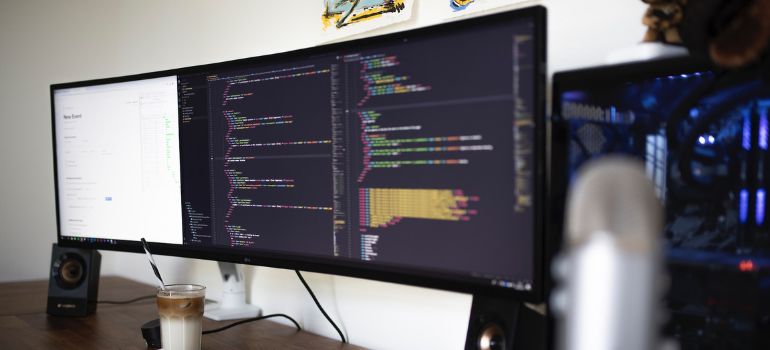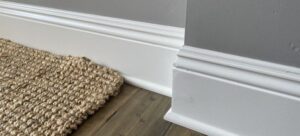Gathering the Necessary Tools
Before you start the process of mounting your TV on the wall, it’s essential to gather all the required tools and materials. Having the right equipment on hand will make the installation smoother and more efficient. Here’s a list of the tools you’ll need:
- Stud Finder: A stud finder helps you locate the wall studs, which are essential for securely mounting the TV bracket.
- Drill and Drill Bits: You’ll need a drill to create holes in the wall for the mounting bracket and possibly for wall anchors.
- Screwdriver: A screwdriver is necessary for tightening screws and bolts during the installation.
- Wall Mount Bracket Kit: Ensure you have the correct wall mount bracket kit that matches your TV’s size and weight specifications.
- Level: A level is used to ensure that the TV will be mounted straight and not tilted to one side.
- Measuring Tape: You’ll need a measuring tape to determine the precise height at which you want to mount the TV.
- Socket Wrench: A socket wrench may be required to tighten bolts or screws, depending on the mounting bracket.
- Assistant (Optional): While not a tool in the traditional sense, having a friend or family member to assist you in lifting and mounting the TV can make the process much easier and safer.
Measuring and Marking the Wall
Once you’ve gathered all the necessary tools, the next step in mounting your TV to the wall is measuring and marking the wall accurately. This step is crucial to ensure that your TV will be positioned at the desired height and level.
Follow these steps to measure and mark the wall:
- Select the Mounting Location: Decide where you want to mount your TV on the wall. Consider factors like the TV’s optimal viewing height, the room layout, and any potential obstructions.
- Use a Measuring Tape: Take a measuring tape and measure from the floor to the desired height where the center of the TV will be. This measurement will serve as your reference point.
- Mark the Wall: With your measuring tape, make a small pencil mark on the wall at the height you’ve determined. This mark represents the center point where the TV bracket will be installed.
- Check for Wall Studs: Use a stud finder to locate the wall studs near the marked point. Wall studs provide the necessary support for mounting heavy TVs. Mark the edges of the nearest studs on the wall.
- Use a Level: Place a level horizontally across the wall, ensuring it’s aligned with the mark you made. This will help you ensure that your TV will be mounted level and not crooked.
Mounting the Bracket
Now that you’ve measured and marked the wall, it’s time to proceed with mounting the TV bracket securely. The TV bracket is the essential component that will hold your TV in place on the wall.
Follow these steps to correctly mount the bracket:
- Review Manufacturer’s Instructions: Start by carefully reviewing the manufacturer’s instructions that came with your TV bracket kit. Different brackets may have specific requirements and steps.
- Position the Bracket: Hold the TV bracket against the wall, aligning it with the marks you made earlier. Ensure that the bracket is centered and level, using the reference points you established.
- Mark Hole Locations: While holding the bracket in place, mark the locations of the screw holes on the wall. These marks will indicate where you’ll need to drill holes for the bracket.
- Drill Pilot Holes: Use an appropriate-sized drill bit to create pilot holes at the marked locations on the wall. If you’re drilling into studs, make sure the pilot holes go through the studs for maximum stability. If not, use appropriate wall anchors as recommended by the bracket instructions.
- Attach the Bracket: Securely attach the TV bracket to the wall using screws and/or bolts as specified in the instructions. Make sure the bracket is level and firmly anchored to the wall.
- Double-Check Alignment: Once the bracket is attached, double-check its alignment using a level to ensure it’s perfectly straight and level. Make any necessary adjustments.
- Tighten Bolts and Screws: Ensure that all bolts and screws are tightened securely. Loose fittings can lead to instability, so this step is crucial for safety.
- Test Bracket Stability: Gently test the stability of the bracket by applying slight pressure in different directions. It should remain firmly in place without wobbling.
Preparing the TV
Remove the TV stand if it’s attached and ensure that the TV is in the “off” position. Place it face down on a soft surface to avoid scratches on the screen.
Lifting and Securing the TV
With the TV bracket securely mounted on the wall, it’s time to safely lift and secure your heavy TV onto the bracket. This step requires caution and precision to avoid accidents or damage to the TV.
Follow these steps to lift and secure your TV:
- Enlist a Helper: It’s strongly recommended to have a friend or family member assist you in this step. Lifting and mounting a heavy TV alone can be challenging and unsafe.
- Turn Off the TV: Before lifting the TV, ensure that it is powered off and unplugged from any electrical outlets. This reduces the risk of electrical accidents during the process.
- Prepare a Soft Surface: Place a soft surface, such as a clean blanket or a soft carpet, on the floor directly in front of the wall where the TV will be mounted. This surface will act as a cushion in case you need to place the TV down.
- Lift the TV Carefully: Both you and your helper should lift the TV simultaneously from the sides, holding it securely but avoiding touching the screen. Ensure that the TV is in a horizontal position to prevent any damage.
- Align with the Bracket: Carefully align the back of the TV with the bracket on the wall. Follow the manufacturer’s instructions to guide you in attaching the TV securely to the bracket.
- Attach the TV to the Bracket: Depending on your specific TV and bracket, this may involve sliding the TV onto the bracket or securing it using hooks or screws. Ensure that the TV clicks into place or is securely fastened.
- Check for Stability: Once the TV is attached, check for stability. Gently push and pull the TV to ensure it’s securely fixed to the bracket and doesn’t wobble.
- Secure Additional Safety Features: Some TV brackets come with additional safety features like locking mechanisms or straps. If your bracket includes these, use them to provide extra security.
- Ensure Proper Weight Distribution: Make sure that the weight of the TV is evenly distributed on the bracket. An imbalanced TV can put stress on the mount and compromise stability.
- Test Tilt and Swivel (if applicable): If your bracket allows for tilting or swiveling the TV, test these features to ensure they work correctly.
Checking for Stability
Once your TV is securely mounted on the wall bracket, it’s essential to ensure that it’s stable and properly aligned. Checking for stability will help prevent any potential accidents or damage to your TV.
Follow these steps to check for stability:
- Visual Inspection: Begin by visually inspecting the TV to see if it appears level and aligned with the wall bracket. It should be parallel to the wall and not tilted to one side.
- Gentle Push and Pull: Gently push and pull the TV in different directions to check if it wobbles or moves excessively. A stable TV should remain securely attached to the bracket.
- Tighten Any Loose Fasteners: If you notice any bolts, screws, or other fasteners that appear loose, use the appropriate tools to tighten them. Loose fasteners can compromise stability.
- Check Wall Anchors: If you’re not mounting the TV directly into wall studs, inspect any wall anchors or toggle bolts you used. Ensure they are securely holding the bracket to the wall.
- Use a Level: Place a level on top of the TV to verify that it’s perfectly horizontal. If it’s not level, make the necessary adjustments to the bracket to correct it.
- Test Tilt and Swivel (if applicable): If your bracket allows for tilting or swiveling the TV, test these features to ensure they function smoothly and securely.
- Inspect Cable Connections: Ensure that all cables, including power, HDMI, and audio cables, are securely connected to the TV and any external devices. Loose cables can affect stability.
- Recheck Wall Studs: If you’re uncertain about the position of wall studs, reconfirm their locations using a stud finder. Ensure that the TV bracket is anchored securely to the studs for maximum stability.
- Double-Check Bracket Locking Mechanisms: If your TV bracket has locking mechanisms or safety features, ensure that they are engaged and holding the TV in place.
- Listen for Unusual Noises: Pay attention for any unusual creaking or cracking noises when adjusting or testing the TV. Such sounds could indicate a problem that needs attention.
Cable Management
Proper cable management is essential for a clean and organized appearance when mounting your TV on the wall. Well-organized cables not only improve aesthetics but also help prevent accidents and make maintenance easier.
Follow these steps for effective cable management:
- Select Cable Management Solutions: There are various cable management solutions available, such as cable clips, cable sleeves, raceways, and wall-mounted cable covers. Choose the option that best suits your needs and preferences.
- Identify Cable Routes: Determine the paths where your cables will run from the TV to other devices, such as gaming consoles, Blu-ray players, or cable boxes. Consider the shortest and most discreet routes.
- Secure Cables to the Wall: Use cable clips, adhesive-backed clips, or cable sleeves to secure cables to the wall. Arrange them neatly along the chosen routes, ensuring that they are hidden from view as much as possible.
- Use Cable Ties: Bundle together multiple cables using cable ties or Velcro straps. This prevents them from tangling and adds to the tidiness of your setup.
- Conceal Cables Behind Furniture: If possible, place furniture or decorative items strategically to conceal the cables. This not only hides the cables but also adds a decorative element to your space.
- Route Cables Through Wall: For a truly clean and hidden cable management solution, you can route cables through the wall. This may require professional installation to ensure safety and compliance with local building codes.
- Label Cables: To make future maintenance easier, label each cable with its purpose or destination. This helps you identify and troubleshoot any issues quickly.
- Test Cable Connections: After managing the cables, ensure that all cable connections remain secure. Check that cables are firmly connected to both the TV and the connected devices.
- Regularly Inspect and Adjust: Over time, cables may shift or become loose. Periodically inspect and adjust your cable management to maintain a clean and organized appearance.
Connecting the TV
Connect all necessary cables, such as power, HDMI, and audio, to your TV and other devices. Ensure a secure and snug fit to prevent disconnection.
Testing the Setup
Turn on the TV and verify that it’s functioning correctly. Check all inputs, channels, and sound settings to ensure everything is in working order.
Troubleshooting
If you encounter any issues during setup or operation, refer to the TV and wall mount bracket instructions for troubleshooting tips. Seek professional assistance if needed.
Safety Precautions
Always prioritize safety when handling heavy objects. Use proper lifting techniques, and if you have any doubts about your abilities, seek assistance.
Maintenance and Care
Regularly inspect the wall mount and TV for any signs of wear or damage. Keep the area around the TV clean to prevent overheating.
Frequently Asked Questions (FAQs)
Ideally, you should mount your TV on a wall with studs for maximum stability. However, some walls may not have studs, in which case you’ll need appropriate anchors.
While it’s possible to do it yourself, seeking professional installation may be advisable, especially for larger and heavier TVs.
If you don’t have assistance, consider using a TV wall mount with a built-in lifting mechanism or consult a professional installer.
You can use cable management kits or hire a professional to hide cables behind the wall for a clean and organized look.
Yes, you can mount a TV on drywall, but make sure to use appropriate wall anchors and follow the manufacturer’s recommendations.
Conclusion
Mounting a heavy TV to a wall mount can be a challenging but rewarding DIY project. By following the steps outlined in this guide and prioritizing safety, you can enjoy a clutter-free living space with a stylish wall-mounted TV. Remember to regularly inspect and maintain your setup for long-lasting enjoyment.



